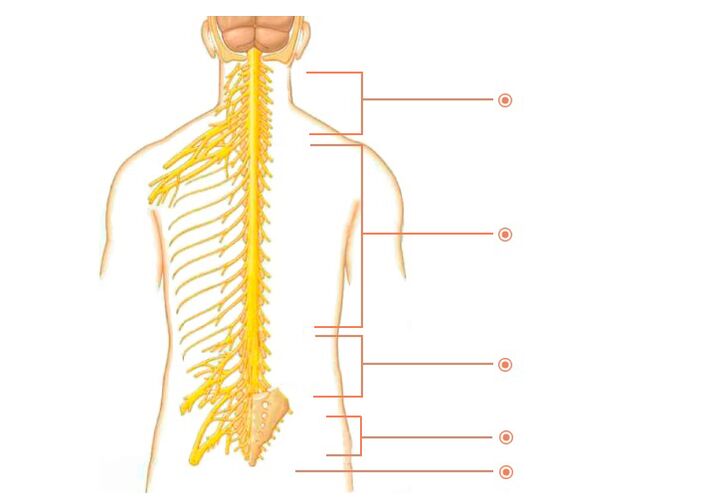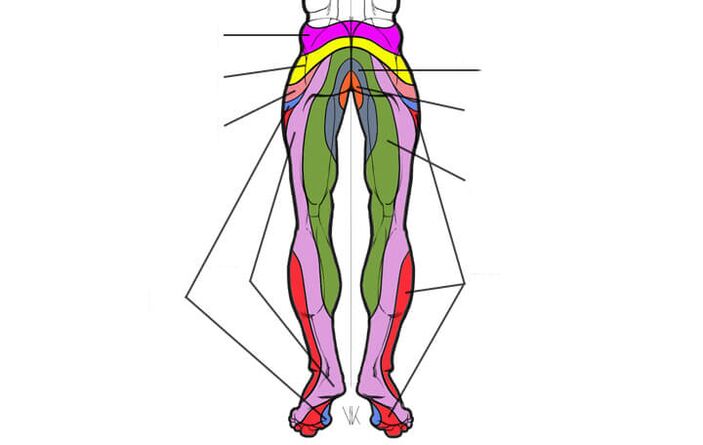Lumbar spondylosis is a degenerative disease of the vertebrae and discs. It is generally accepted that lumbar osteochondrosis affects both the spine itself and the nerves and blood vessels. Therefore, the symptoms of lumbar spondylosis are divided into those that affect the spine itself - these are called vertebral/vertebral syndromes - and those that appear outside the spine, with the involvement of neural and vascular structures - these are called non-vertebral / extravertebral syndromes. In turn, in addition to the disc is divided into reflex and lens syndromes. Since the word "syndrome" implies a group of symptoms, it can be simplified and said that the symptoms of lumbar spondylolisthesis include three groups - vertebrae, reflexes, and lenses.
Vertebral symptoms of osteonecrosis of the lumbar spine
- Violation of the configuration of the spine (curvature);
- Muscle tension of the lower back;
- Violation of mobility of the lower back;
- Localized back pain.
Reflexive symptoms of lumbar osteonecrosis
The main reflex symptom is back pain. It can be sudden or permanent. Pain that occurs after physical activity or from clumsy movements. For example, when turning, leaning or lifting weights. Appears muscle tension and stiffness of movements - usually occurs in the morning. There were shootings in the back or in the leg. The sensitivity of the lower extremities is impaired - numbness, goosebumps, piercing or burning. Changes in gait and coordination. Increased sweating. The work of the intestines and bladder is often disturbed. There are malfunctions in the work of internal organs. Sexual function is affected. Sleep is disturbed due to pain. Mood swings, irritability and fatigue appear. Sometimes there is depression.
Trigger factors for exacerbations are exertion, prolonged uncomfortable posture, hypothermia, and stress.
The pain reflex symptoms of lumbar osteochondrosis, depending on the severity and localization of the process, are often divided into low back pain, hemiplegia and hemiplegia.
- Lumbago (low back pain)the most acute pain. Provocation is a clumsy movement, sneezing, coughing. To alleviate his condition, the patient involuntarily leans forward or bends to the side. Trying to stay upright causes new back pain.
- Lumbalgia"Tolerable" pain, with exacerbations. Over time, it develops into constant intense pain.
- Sciatica body painPain extending from the back to the legs.
Lens symptoms of lumbar osteonecrosis
They occur due to impact on the nerves that come out of the spine.
There are many nerves that come out of the spine. These are called spinal nerves. Each such nerve gradually branches and follows a certain region of the body with well-defined boundaries. This area is called the segmental intrinsic region. Each vertebra, disc, nerve, and region is numbered accordingly. If a nerve is affected, symptoms will appear in the area of the inner segment that corresponds to this nerve, and not just anywhere - in an arbitrary place.

spinal nerves
Lens symptoms of osteonecrosis of the lumbar spine include:- decreased or lost reflexes;
- muscle weakness;
- violation of sensitivity;
- bone pain.
Not all parts of the lumbar spine are equally susceptible to pathology. The most mobile segments are more commonly affected: L3-L4, L4-L5, and L5-S1. As the principle - "More movement - more wear. "


Inner regions of the lumbar segments
Osteonecrosis L3 – L4- affects the spinal nerve L4. Main sign: weak jerking of the knee. Pain, numbness, and decreased sensitivity disturb the anterior aspect of the thigh.
Osteonecrosis L4 – L5- affects the spinal nerve L5. The main sign: weakness in the muscles that lift the big toe and foot. The patient can hardly continue to stand on his heels. Disturbing pain, numbness, and desensitization from the lower back to the buttocks and thighs "along the stripe", then through the lower leg, gradually moving to its front part and ending at the first three toes of the tablefoot.
Bone tumor L5 – S1- affects the spinal nerve S1. The main sign: weakness in the calf muscles. The patient can hardly continue to stand on tiptoe. Pain, numbness, and decreased sensitivity are detected from the buttocks, then along the back of the thighs and shins, moving to the side of the foot and little finger.
Sometimes, with lumbar osteonecrosis, not only the nerves but also the lens arteries can be affected. This threatens the development of the most dangerous pathology - a stroke of the spine, with severe consequences for a person - paralysis and paralysis, as well as severe malfunction of the pelvic organs.
Symptoms of lumbar spine osteonecrosis:
- depends on the stage of bone necrosis;
- aggravated by tilting and turning;
- usually appear more after 30-35 years;
- Women are about three times more likely to get the disease than men.
You, of course, notice that the lens symptoms are well defined, and the reflex symptoms are very vague and ambiguous. And as you know, everything without a clear definition serves as a convenient cover for professional impotence. This applies, among other things, to reflex symptoms, and a favorite concept among doctors is "age-related changes". Surely many of you are familiar with situations where doctors explain problems using "reflexive" or "age-related" procedures. Most people at such times rightly believe that the doctor simply cannot understand what is going on and is trying to cover his incompetence in a fog of "words". say this magic".
There was once a popular saying: "Every accident has a first name, last name and position". Each disease has its own unique symptoms. And it is the doctor's duty to know them clearly. And then there will be no need to let the fog, and blame the degenerative process of the cervical spine for everything. You now understand how important it is to find an experienced and knowledgeable doctor. Both the correct diagnosis and the outcome of treatment will depend on this.
When choosing a clinic, it is important to find an experienced and knowledgeable doctor.
Diagnosis of lumbar osteonecrosis
To date, there are several methods of hardware diagnosis of osteonecrosis by hardware. The most accurate of these are MRI and CT. But the main method remains clinical diagnosis - this is when an experienced physician compares data from at least three sources - from patient complaints, MRI results and symptoms he reveals inexamination process. This allows you to make the most accurate diagnosis and create an effective individualized treatment program.
Treatment of lumbar osteonecrosis
As you already understand, osteonecrosis is a real "bundle" of symptoms that, if cleared up, will save you from pain and anguish. But it is not possible to eliminate changes in the vertebrae and discs. Therefore, the two words "bone necrosis treatment" must be understood correctly. If you are interested in getting rid of pain and other suffering, then yes - it is quite possible. And if you conduct an academic discussion on the subject of returning the vertebrae and discs to their original appearance, "like a newborn baby", then no, the past cannot be returned. You need to be realistic, and then you won't fall prey to scammers.
Don't fall prey to scammers!
The vertebrae and discs cannot be returned to their original state!
What is the main treatment?
Soft hand therapy is the main type of treatment for lumbar osteonecrosis. It's like an antibiotic for pneumonia - you can't go without it. Others - massage, medication, physiotherapy and exercise - are auxiliary.
How does gentle manual therapy work?
The nutrition of the intervertebral discs is directly related to the muscles surrounding the lumbar vertebrae. In addition, it is the muscles of the lumbar region that are one of the causes of the pain of lumbar osteochondrosis. Manual soft therapy is a special method that allows you to return the muscles to their natural physiology, eliminate spasms, clamp muscles and improve disc nutrition.
The intervertebral discs are the only part of the body that does not have blood vessels and is nourished by the normal functioning of the muscles.
In addition, when treating with the help of hands, the orthopedist:
- remove the load from the affected vertebrae and discs and distribute it correctly
- relax the muscles and help them return to normal
Thereby:
Manual impact will mobilize the body's internal force and start the self-healing mechanism. The treatment is absolutely safe.
The clinic uses all soft hand therapy methods:
- reduce patient's clamp
- improve transmission power
- Restoration of bodily functions
normalize blood circulation
The qualification of a doctor of any professional clinic gives you the freedom to use all these methods for the treatment of cervical osteosarcoma. Also, in each case we combine them, taking into account the synergy effect.
Synergy is not just a bunch of different influences, it's a precise sequence in a combination of methods. Synergy leads to additional therapeutic qualities. A simple example of synergy is our hands. How long does it take to tie a knot? Second? !And if you do it with one hand, you can't manage it for a minute. That is, doing it with two hands is not twice as fast as one, but many times faster. And listening to the same piece of music performed by individual instruments or by an entire orchestra together - is there a difference? This is the effect of synergy - it makes you able to do things more powerfully, more efficiently and faster, but at the same time - more carefully.
Complementary therapies - medication, massage, physical therapy and exercise therapy
Drug treatment.In the treatment of osteonecrosis of the lumbar spine, drugs with a different spectrum of action are used. These are drugs that reduce deep tissue swelling, inflammation, and pain. The drug improves blood circulation. In addition, drugs are used to help restore damaged cartilage tissue of discs and pinched nerves - chondroprotectors and B vitamins. Take the drug in combination with other treatments, if necessary, prescribed by an orthopedic surgeon.
Massage.As you know, there is massage for entertainment and massage for healing. Recreational massages are performed in spas, and therapeutic massages are performed in medical clinics. At the clinic, medical massage is performed in a gentle manual therapy session. To increase the effectiveness of manual treatment and normalize metabolism - all this can be therapeutic massage!
Physical therapy.There are many physical therapy methods to help manual therapy in the treatment of lumbar degenerative bone disease, such as treatment with ultrasound, electrophoresis, laser, etc. The orthopedist will give a specific recommendation. body.
Physical therapyExercise regularly to strengthen muscles. The main thing is to do the right exercises without sudden movements. During the treatment at the specialist clinic, the doctor will give you the necessary exercises. Pilates is the best option.
Prevention of lumbar osteonecrosis
To avoid recurrence, create comfortable conditions for yourself while sleeping and working. Monitor your weight and proper nutrition. Maintain your physical activity. But the main thing is not to neglect your health and not save on it. Don't let things pass. After recovery, try to do at least one gentle manual therapy maintenance session every three to six months - this will reduce risk factors. Don't forget, neglected osteonecrosis leads to complications of bulging eyes and disc herniation. Remember: your health, first of all, you need!
Running ossification leads to complications - eye protrusion and disc herniation.
Benefits of treating osteonecrosis in a specialist clinic:
- Ensure adequate and qualified treatment. The word "complete" is key in our work.
- We consider each case individually and holistically - without formalism.
- Composite effect.
- Guaranteed honesty and fair pricing.















































